
 |
JPL's Wireless Communication Reference Website
Chapter: Wireless Channels
|
AM broadcast radio can cover large distances, because of propagation along the earth surface. The ITU has gathered propagation curves to predict the received field strength for various frequencies in the long wave and medium waveband. The conductivity and permittivity of the earth appeared to be important parameters. The curves are given for a 1 kw transmitter with a short monopole antenna, so these need to be corrected for the transmitt power and the antenna gain relative to the monopole.
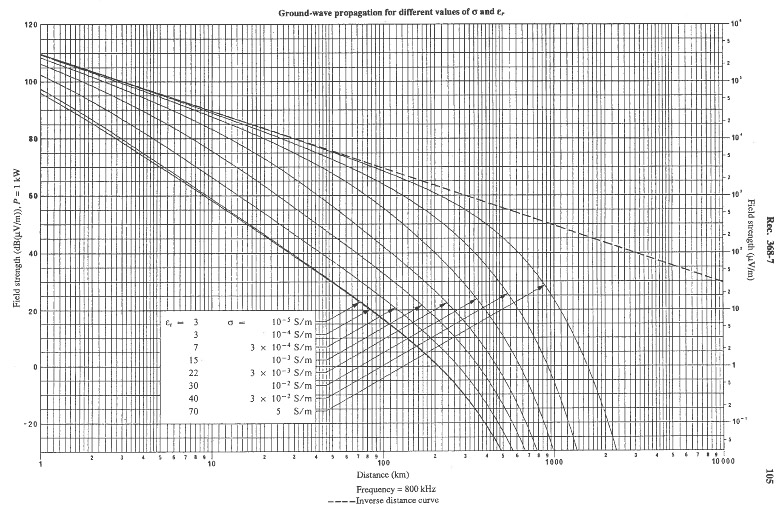
Figure: source credit: Propagation curves from ITU-R recommendations Propagation in non-ionized media.
Received field strength as a function of propagation distance for 800 kHz. ITU-R provides curves in 200 kHz steps
(for planning see also:
BS-series, Broadcasting Sound. )
An interesting site is also http://www.wabweb.net/radio/radio/grundl3.htm

For the range of a mediumwave broadcast transmitter, the conductivity of the of the ground is an important factor. The CCIR / ITU-R has published maps for this. An example is given below for The Netherlands.
For proper reception, the signal must adhere to at least two requirements
1: the received filed strength must be minimum protected field strength. Typically man-made noise is a key determining factor.
Note that noise levels in the mediumwave band are rapidly increasing, since 2004 in particular due to LED lighting, smart phones, computers, IoT devices etc.. Moreover, typical consumer receivers cannot receive signals weaker than 1 mV/m, and require significantly stronger signals to deliver a listenable audio quality.
See for instance :
- Technical Planning Parameters and Methods for Terrestrial AM broadcasting, on the web you can find an example of a document released by the Australian Broadcasting Authority, 2004.
- In the 70s, in the Netherlands, a lower minimum required field strength was used, but in the 80s it was recognized that at least 77 dBuV/m was needed also during day time, and 25 Million Dutch guilders was invested in a new transmitter site to increase the field strengths to levels for adequate reception. Sence then man made noise levels have increased substantially [KIVI, NERG: https://www.kivi.nl/uploads/media/5702340b3d6c2/44-03-1979.pdf].
2: any interfering signal must be 30 dB below the wanted signal. Preferably even a protection ratio of 40 dB applied but at night time this appeared to be impractical as it would prohibit efficient international reuse of the AM radio band
Example: High Power National Coverage in a country with wet soil. A 100 kw transmiitter (+30 dB above 1 kwatt) to a quiet sub urban village (protection field strength is 68 dBuV). The station can reach many hundreds of kilometers via groundwave, yet sky wave propgation may cause multipath fading during nght tme)
Example: LP-AM from a ship at sea. A Low-Power AM station 25 watt (100 PEP) AM station from a ship at sea to a rural area. Sea water conducts very well and high masts have been mounted on ships for broadcast purposes. We assume 0 dB antenna losses. Thus the ERP is 26 dB below 1 kw. In a rural area 54 dBuV must be reached. We see from the curve that the station can serve listerners at 30 km distance.
Example: LP-AM in City: A Low-Power AM station 25 watt (100 PEP) in a city larger than 20,000 inhabitants on poorly conducting ground (e.g. epsilon = 7). If the antenna would have zero losses, the ERP is 16 dB below 1 kwatt. The signal must be above 80 dBuV to be adequately above city noise levels coming from switch mode power supplies, cars, LED lighting, etc. Thus in the curve for a hypothetical 1 kW transmitter we must find the point where 96 dBuV is achieved. This is at a distance of about 1.5 km.
Typically antennas for LP-AM have 10 .. 20 dB losses and the coverage area for comfortable listering is much smaller. 80 dBuV/m is achieved at about 1km, for a good antenna with only 10 dB losses.
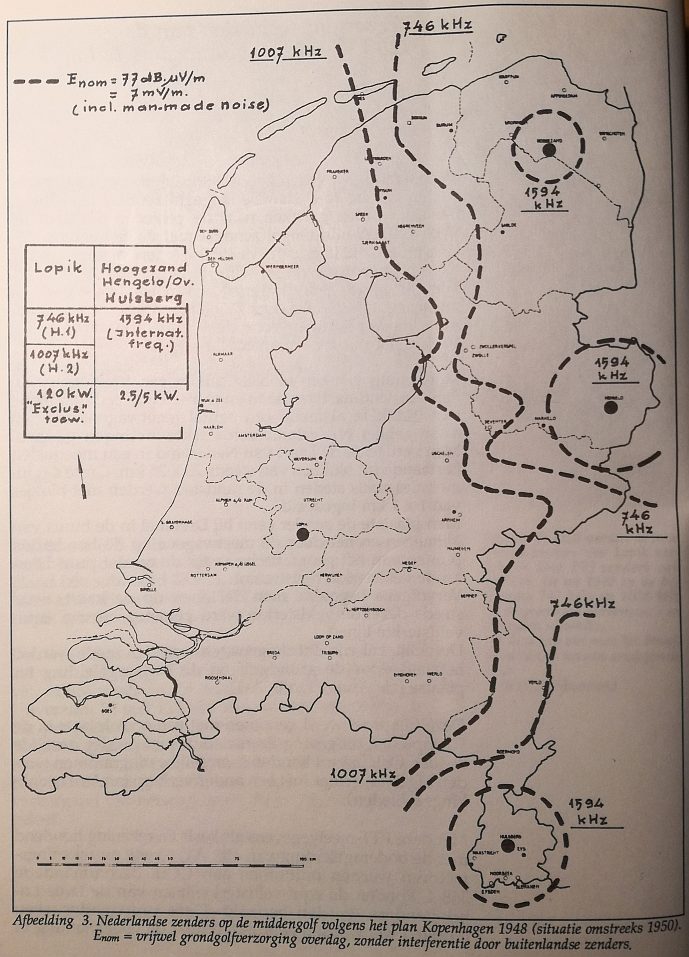
While this ground wave propagation dominates during day time, during night time a sky wave also contributes significantly. That is, radio energy is reflected against the ionosphere and is bent back to the earth surface. The sky wave can cover much larger distances than the ground wave. Hence the sky wave results in a secondary coverage area.
Example: RTL 208, Radio Luxembourg
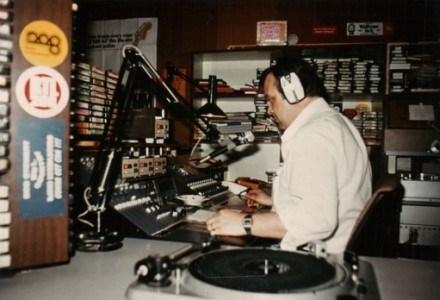
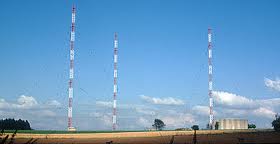
An historic example were the transmissions on 1440 kHz (208 meters) from Luxembourg. During the day time, the frequency was used to cover Luxembourg and large parts of Germany with a German language service, by ground wave while after sunset, the frequency was used to cover the United Kingdom by skywave. The transmit power was 1300 kilowatt.
In "radio Spectrum Management"David Wither describes the dilemma that an AM broadcast has: The groundwave offers a primary coverage area, and the sky wave offers a secondary zone, but these are not contiguous. There is a fading zone in betwen where the ground wave and skywave interfere. Rabdom phase daleys in the ionosphere lead to a time varying, frequency selective fading, that clearloy "distorts" the audio quality.
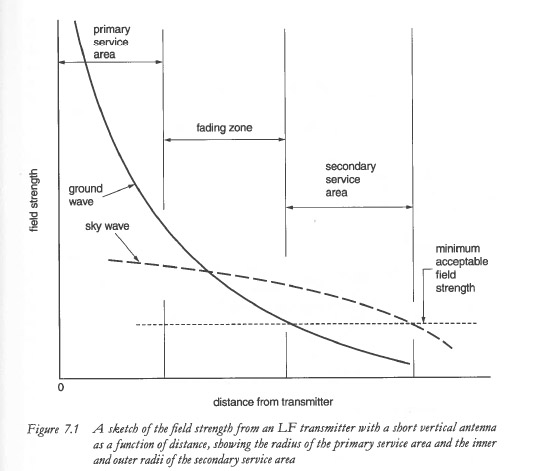
Source Credit: David Wither, Radio Spectrum Management, 2nd edition, IEE Telecommunication Series 45, UK.
The coverage of AM stations typically differes during day time and night time, in some cases it increases at night, in other cases it decreases:
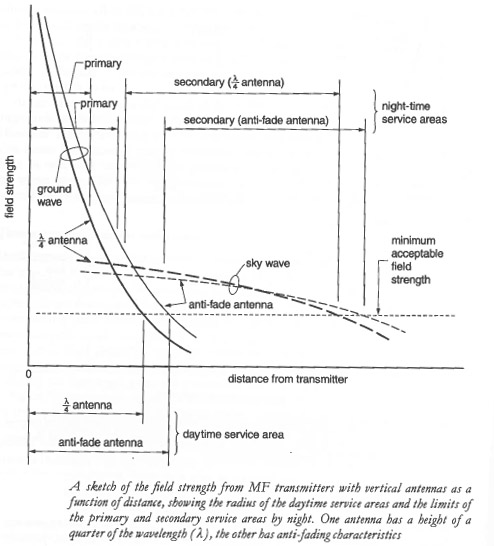
A broadcast organisation in The Netherlands want to reach 1,000 Dutch listeners travelling in neighboring countries Western Europe. It has three options
Q1: Compare these solutions in terms of spectrum occupancy (expressed in Hz.m2)
Q2: Compare these solutions in terms of power consumption (watts)
Q3: Make a business case for such a radio servvice.
Example: 747 kHz transmission 500 .. 600 kilowatts from the FlevoPolders in The Netherlands.
Source credit: unknown propagation planning tool